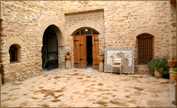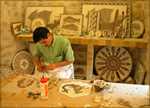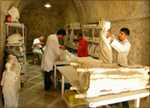
Borj Sidi al Bsili, built in 1801, is a valuable illustration of early XIXth century Tunisian military architecture. It is also one of the rare remains that have survived of the imposing fortifications built in Tunis by the Husseinid bey Hammouda Pacha (1782-1814) on the eve of the conflict with the deys of Algiers. The construction work was entrusted to the Dutch engineer Homberg whom the reformer prince also charged with rehabilitating the country’s main fortifications.
The quadrangular shaped building is composed of a ground floor and a first floor. The casemate and ancillary rooms are organised around a small central courtyard. A ramp served to haul the cannons and munitions to the upper level and to the wall walk. The very thick outer walls are made of rammed earth reinforced with stone blocks. This technique provided the building with great elasticity and was efficient in offsetting the effect of impacts from cannon balls. Despite its considerable size, the monument was only a simple artillery bastion flanking the eastern part of the surrounding walls of the northern suburb of Tunis (Rbat Bab Souika). The bab al Khadhra and Sidi Yahia bastions belonged the same building campaign. Because of its configuration it constituted a sort of independent fort that would have been able to continue fighting after the other fortifications had been overcome.



Le programme de reconversion comprenait la création d’un atelier de production d’objets dérivés du patrimoine (plâtre et mosaïque), logé dans les locaux de rez-de-chaussée. L’étage, quant à lui, fut transformé en espace d’animation et d’exposition.
Les objets dérivant du patrimoine sont des produits recherchés par les visiteurs en guise de souvenirs à usage esthétique ou pratique.
Head of Jupiter
Mask with an Egyptian
influence
Demeter Statute
Esculape G.M
Head of Demeter
Esculape S.M
Head of Pan
Greek Tragic Mask
Vase in the shape
of a woman's head
Relief of the dance
of the Maenads
Circular-shaped
oil lamps